This Year’s Top 10 Emerging Technologies, According to the World Economic Forum
BigThink
Philip Perry
Recently, the World Economic Forum’s Expert Network and Global Future Councils, teamed up with the board of directors of Scientific American, to determine the top 10 breakout technologies for this year.

